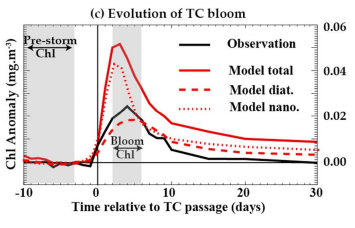Global impact of tropical cyclones on primary production
Abstract
In this paper, we explore the global responses of surface temperature, chlorophyll, and primary production to tropical cyclones (TCs). Those ocean responses are first characterized from the statistical analysis of satellite data under ~1000 TCs over the 1998–2007 period. Besides the cold wake, the vast majority of TCs induce a weak chlorophyll response, with only ~10% of induced blooms exceeding 0.1 mg m−3. The largest chlorophyll responses mostly occur within coastal regions, in contrast to the strongest cold wakes that generally occur farther offshore. To understand this decoupling, we analyze a coupled dynamical-biogeochemical oceanic simulation forced by realistic wind vortices applied along observed TC tracks. The simulation displays a realistic spatial structure of TC-induced blooms and its observed decoupling with TC cold wakes. In regions of strong TC energy input, the strongest cold wakes occur in regions of shallow thermocline (<60 m) and the strongest blooms in regions of shallow nitracline and/or subsurface chlorophyll maximum (<60 m). Shallow thermoclines are found over many open ocean regions, while regions of shallow nitracline and/or subsurface chlorophyll maximum are most prominent in near-coastal areas, explaining the spatial decoupling between the cold and bloom wakes. The overall TC contribution to annual primary production is weak and amounts to ~1%, except in a few limited areas (east Eurasian coast, South tropical Indian Ocean, Northern Australian coast, and Eastern Pacific Ocean in the TC-prone region) where it can locally reach up to 20–30%. Nearly 80% of this TC-induced annual primary production is the result of the biogeochemical response to the 30% strongest TCs.


